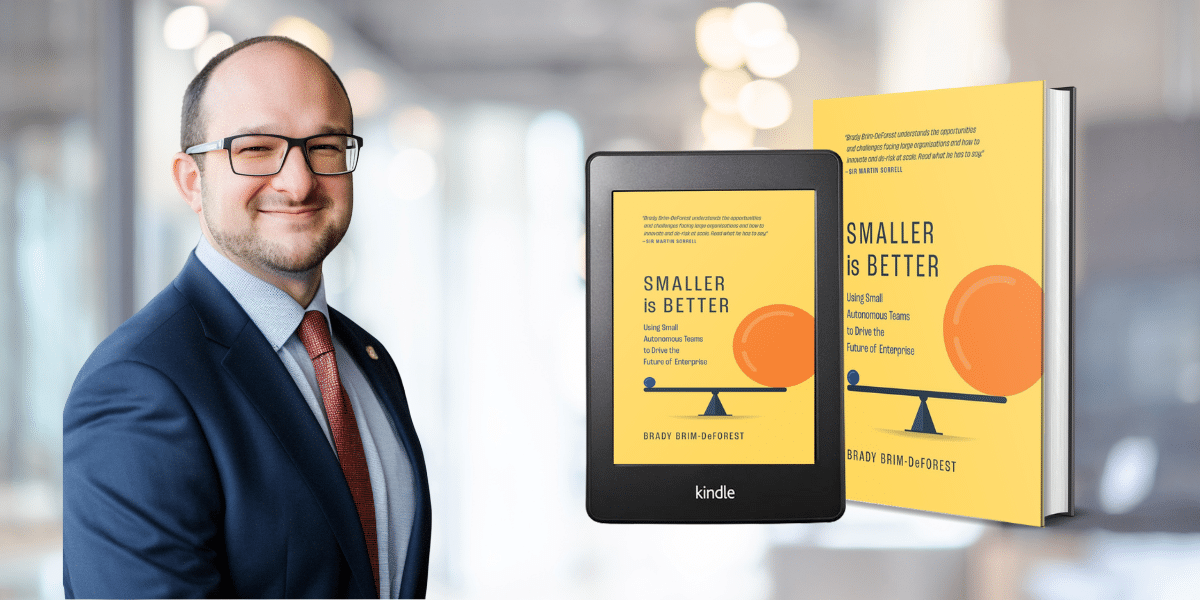By: James Futchner
Brady Brim-DeForest, a renowned serial entrepreneur and CEO, will be joining us to discuss the intersection of organizational innovation, emergent technologies, and the strength of small teams. Brady possesses a multitude of experience in the development of innovative and agile teams, having co-founded six successful businesses and led the technology solutions division at Media.Monks. His journey has emphasized the significance of embracing failure, cultivating a culture of continuous improvement, and utilizing real-time feedback. Brady elaborates on the transformative role of AI in driving innovation, the critical contributions of small, diverse, and autonomous teams to fostering inclusivity and achieving dynamic results, and the ways in which his entrepreneurial experiences inform his perspective on organizational restructuring in this exclusive interview.
How does your background as a serial entrepreneur and CEO inform your perspective on organizational innovation and restructuring?
Having co-founded six successful startups and led the technology solutions division of Media.Monks, I’ve navigated the complexities of building agile, innovative teams from the ground up. These experiences taught me the importance of embracing failure, fostering a culture of continuous improvement, and the need for real-time feedback within teams.
In the startups I’ve been part of, we’ve often had to be scrappy, leveraging autonomy and the agility of small teams to outmaneuver more significant, more sluggish competitors. This approach has not only allowed us to innovate rapidly but also to create a work environment where team members are deeply engaged and invested in the outcomes of their work. My journey through the startup world has underscored the critical role of leadership in facilitating a shift towards more dynamic, responsive organizational structures, proving that smaller, more focused teams can drive outsized results.
You’ve worked extensively with AI and technology solutions. How do you see emerging technologies intersecting with the principles outlined in “Smaller is Better” to drive organizational transformation?
Emerging technologies, particularly AI and machine learning, play a crucial role in enhancing the effectiveness of small, autonomous teams. These technologies can automate routine tasks, provide sophisticated data analysis capabilities, and facilitate better decision-making processes. This not only frees up team members to focus on more strategic and creative tasks but also enables teams to adapt and respond to changes more swiftly. Integrating AI tools can help teams predict customer behaviors, optimize operations, and innovate product offerings, further aligning with the principles of agility and efficiency central to “Smaller is Better.” The intersection of AI with the small teams model exemplifies how technological advancements can drive organizational transformation, making enterprises more responsive, innovative, and competitive in a rapidly evolving market landscape.
Diversity is mentioned as one of your areas of expertise. How do small, autonomous teams contribute to fostering diversity and inclusion within organizations?
This structure inherently values and leverages a wide range of perspectives by bringing together individuals from different backgrounds, disciplines, and areas of expertise to achieve common goals. By empowering these teams to make decisions and innovate within their scope, organizations can create a more inclusive culture where every member feels valued and heard. This inclusive environment encourages diversity of thought, leading to more creative solutions and better outcomes. Through such a model, diversity and inclusion become not just HR objectives but integral to the organizational strategy and operational approach, driving more equitable and effective practices across the board.
Can you discuss the role of mentorship in facilitating the transition to smaller team structures and driving innovation within organizations?
As more teams adopt this model, each going through the foundational phases of development, mentorship becomes key in sharing learnings, experiences, and practices. This not only accelerates the learning curve for new teams but also creates a cohesive culture of continuous improvement and innovation across the organization. Experienced team members can mentor newer ones, ensuring that the knowledge and insights gained from earlier implementations enhance the effectiveness and efficiency of subsequent teams. This collaborative approach leads to outcomes previously unattainable, as teams work in concert with one another, leveraging collective wisdom and experience.
What are some potential pitfalls or challenges organizations might face when transitioning to a small team’s model, and how can they mitigate these risks?
When transitioning to a small team model, organizations often face a mix of challenges, including resistance to change, difficulty in altering established work practices, and the tension between the need for quick results and the time required to build a new culture supportive of autonomy and innovation. To mitigate these risks:
- Implement Gradually: Start with a pilot or sandbox experiment to demonstrate the model’s effectiveness before scaling. This approach allows for adjustments and learning from smaller successes or failures.
- Focus on Cultural Change: Address the underlying culture that supports or hinders change. Engaging teams in understanding the why behind changes can help in aligning them towards common goals.
- Ensure Leadership Support: Leadership must fully commit to the model, understanding that initial productivity may dip as the organization transitions. Leaders should focus on long-term gains over short-term metrics.
- Adopt Continuous Learning and Improvement: Embrace a mindset of continuous learning and improvement, allowing teams to iterate and evolve based on real-time feedback and experiences.
- Communicate Clearly: Maintain open lines of communication throughout the organization, ensuring that all team members understand the vision, process, and expected outcomes of the transition.
By focusing on these factors, organizations can navigate the complexities of moving towards a small team’s model, leveraging its benefits while minimizing potential pitfalls.
Website: https://brimdeforest.com
LinkedIn: https://www.linkedin.com/in/bradybd/
Smaller is Better: Using Small Autonomous Teams to Drive the Future of Enterprise
Published by: Khy Talara














